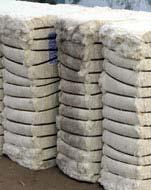
Spot futures are still gravitating towards the 75 cents level and for the past eight sessions the March contract has settled within a very narrow band of less than 100 points,between 74.79 and 75.71 cents/lb.
There have been a few intraday spikes up and down,but last Friday's selloff below 74 cents found ready buyers,while attempts to propel the market beyond the crucial 78 cents resistance area have so far lacked the necessary momentum.
The current level of NY futures actually makes sense when compared to where physical prices are trading,which is in the 83 to 86 cents/lb range,basis Far East main ports.Demand has remained relatively brisk,as mills outside China are currently able to operate with decent profit margins.
The latest US export sales report confirmed this encouraging pace of business,as there were once again over 200'000 bales of Upland and Pima cotton sold to 18 different markets last week.Shipments finally picked up as well,as more than 270'000 bales were exported last week.Commitments for the current marketing year now amount to nearly 9.6 million statistical bales,whereof some 3.8 million have so far been shipped.
Considering that total supply of US cotton amounts to around 20.6 million statistical bales this season and with export commitments/domestic mill use already at 13.1 million bales,there are just 7.5 million bales left for sale.If we do the calculation for Upland cotton only,the number is just around 7.0 million bales.Therefore,with only about a third of the supply left for sale and with next season's crop expected to be a lot smaller,we don't foresee any price pressure on US cotton for the remainder of this season.
To the contrary,the longer we stay at the current price level,the faster some of these sought-after US qualities are likely to sell out,since there isn't really that much competition from other origins around the globe at these prices.
We have already stated ad nauseam that the 45 million bales of Chinese stocks,which are priced at 55-70 cents above the world market,don't pose a threat and won't be able to prevent international prices from rising by 10 or 15 cents.
We feel that this Chinese"vacuum effect"is still not fully recognized by traders,since a lot of analysts continue to see Chinese stocks as a bearish influence on international prices,especially now that the Chinese government intends to release some of its stockpile.However,by stifling its export-oriented textile industry with prohibitively high prices,China has allowed textile production to shift to other areas around the globe,which is leading to higher mill use in many markets.
This trend has yet to be properly reflected in the statistical data!Also,as long as China leaves its doors open to imports be it in the form of raw cotton or yarn,it will help to underpin international prices.In other words,while China is struggling to find ways to deal with the expensive noose around its neck,there simply won't be enough 75 cents cotton available to satisfy demand for too much longer!
The market should also see some support from the macro-economic front over the coming months.After a prolonged period of time during which the Federal Reserve abstained from expanding its balance sheet any further and instead focused on rolling treasuries from shorter to longer-dated maturities(Operation Twist),it has once again cranked up its printing press to full throttle.During 2013,the Fed is expected to expand its balance sheet by about a trillion dollars,from 3 to 4 trillion.
As a point of reference,in 2008 the Fed balance sheet amounted to just 0.8 trillion dollars!The Fed is obviously still engaged in fighting deflationary forces with inflation,and this time around it may actually succeed.
There is a lot of money parked in so-called'safe harbors',from mattresses to the bond market,but with the 10-year Treasury note yielding about 1.9 percent,which is less than the rate of inflation,an increasing number of investors are encouraged to look for higher-yielding assets.
In other words,the'risk on'trade seems to be back in play,which means that assets like stocks,real estate,emerging markets and commodities are likely going to see an inflow of money and therefore higher nominal prices.
Even though some members of the Fed apparently object to this perpetual money printing,we don't expect a policy shift anytime soon,for a lack of viable alternatives.If the Fed were to stop printing the money necessary to buy all these deficit-financing treasuries,then who would be there to take its place?Japan,Europe and China are all running Ponzi schemes of their own and there are simply not enough savings around the globe to mop up these trillions of dollars in shortfalls year after year.
In other words,we shall remain confronted with a choice of two potential outcomes–a deflationary implosion if central banks were to cease the printing of money,or stagflation.Unfortunately the time for a third option,namely for economies to grow their way out of trouble,has long since passed!We therefore expect a continuous debasement of the world's major currencies,which will translate into higher nominal prices of just about everything!
So where do we go from here?The market has been deadlocked for several weeks now and is looking for an excuse to break out.Will tomorrow's USDA report be able to resolve the stalemate?China's crop size will likely increase,but that's not really material to international prices at the moment for the same reason Chinese ending stocks have little bearing on a 75 cents futures market.What we need to watch out for as potential movers are US exports and Chinese imports,both of which should be slightly higher,and may be an increase in mill use outside China.
A bearish report may send the market back towards 70-72 cents,while a neutral to friendly report may spark some new spec buying and trade short-covering,which could challenge the 78 cents resistance level.While we are undecided about the market's fate in the near term,we remain friendly on prices in the longer run.





